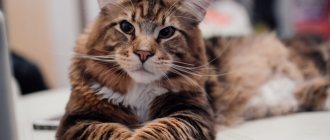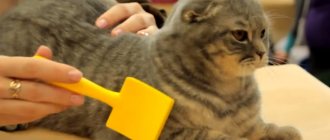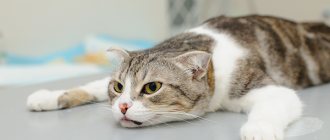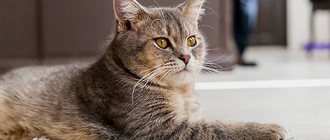Correct placement of the tray
Cats love to go to the toilet in peace and quiet. First of all, you should take care of the location of the tank. If children are running past and the washing machine is running, then the kitten will feel uncomfortable going to the toilet in this place. It is best to place the litter box close to where the kitten likes to spend most of his time. He must wake up and quickly run to the toilet.
Cat owners believe that the tray should be placed near the food bowl. Many kittens go straight to the toilet after eating without learning to tolerate it.
You can gradually move the tank further away, but at first it is advisable that it be close to the bowl and bed. It’s even better to organize a mini-zone where the bowl of food, tray and bed will be close to each other.
A little kitten is a child, he is just beginning to explore the world. You can put him in a tray and give him time to get comfortable. When he has done his business, he needs to be petted and given a treat.
What filler do you use?
Sand from the street
Reasons for sloppiness
Everything is clear with a small kitten; he still doesn’t know how to do everything right. But why does a previously tidy cat begin to mark everything and abandon its nested tray? The reasons may be different:
- If a cat begins to go to the owner's bed , or a cozy soft rug, the reason for this may be pain when urinating, which the animal begins to associate with the litter box. In this case, you need to show your pet to a veterinarian.
- The fluffy little ball learned to be neat, and when he grew up a little, he completely forgot about hygiene. Congratulations, your pet has matured and started marking its territory . The most reliable remedy in this case is castration or sterilization.
- Stress can also cause untidiness. It can be caused by the arrival of a new family member, a change of environment, moving, buying new furniture, or if the cat is scared away from the litter box.
Suitable filler
Many owners skip this important step. But the more correctly the filler is selected, the faster your ward will remember where his toilet is. A natural and safe filler is suitable as a filler: sand, but it requires constant replacement. Granular litters are a good idea. Some manufacturers even offer special fillers - when urine gets into them, they form into a dense lump. It is simply taken out and thrown away.
- Some kittens try to eat litter, so to be safe, choose natural and safe litter.
- It is not recommended to buy brands with fragrances and fillers with antibacterial properties; most of them contain chemicals that are toxic to babies.
- It is also worth abandoning clumping fillers. They are only suitable for adult cats, but for babies this is a serious danger; kittens can swallow the lump.
Litters containing wood and corn pellets are excellent for litter box training. You should not change the litter until the kitten is used to the toilet.
Alluring smells
In order for the kitten to know where its toilet is, it must be guided by smell. You can leave a napkin with the smell of his urine in the tank. This way the baby will understand where his tray is. But after he finishes his job, the tank should be washed thoroughly; felines are very fond of cleanliness.
How to accustom a kitten to the litter box by other means?
Home Remedies
- Mountain lavender. The scent of lavender attracts kittens. A few lavender sachets or plant-scented litter will help with litter box training.
- Cat mint. It has a stupefying effect on the feline - the little one is unlikely to pass by.
Store products
- Ms.Kiss “Litter Tray Accustomed” is a zoohygienic spray that will help accustom a kitten to a litter tray in a certain place. Pros: convenient bottle with ergonomic spray nozzle, good efficiency, low cost. The downside is a rather specific smell.
- Himola “Toilet Training” - bio-spray is designed to develop a strong habit of using the litter box in your kitten. Pros – it sprays easily, attracts the kitten’s attention to the tray. The downside is an unpleasant, persistent smell.
- Api-san “Toilet training” is a smart spray for training a kitten to a litter box or a certain place on the street. It is highly effective, but has a pungent odor.
- Stop Problem “Tray training” – hygiene spray. Designed to correct the kitten's behavior and will help facilitate the process of accustoming the baby to the tray. Pros: pleasant smell and effectiveness. Disadvantage: not suitable for training adult animals.
What is the spray and how to use it?
A spray is a special tool for teaching a kitten to go to the tray in the form of a solution containing specific components. The substances included in its composition contribute to the development of a reflex in the baby to relieve his natural needs in a container filled with filler. A “smart” drug helps speed up the process.
You can accustom a kitten to the tray using a spray in the shortest possible time. For some it only takes a couple of days, for some pets it takes a little longer.
The application scheme is as follows:
- you need to remove the protective cap;
- take a piece of paper and treat it with the preparation from a distance of 20 - 30 centimeters;
- Place it near where the baby sleeps. The paper needs to be gradually moved in the direction of the cat’s “house”. The processed paper can be placed directly into it or nearby.
Tray training spray
The effect of the spray is based on the fact that kittens go to the toilet following a certain smell. And soon they begin to actively use the box with filler for its intended purpose.
Host mistakes
When bringing a new family member into the home, many owners make the same mistakes - it’s worth learning about them in advance so as not to repeat them. Firstly, the tray should be located within reach - the baby should not run around the house looking for it, and secondly, the tank should be suitable in size for a small kitten, and it should not include high sides in its design.
Scolding, and especially hitting, is strictly prohibited. So the baby will forever cease to want to obey its owners, and will not go to the tray prepared for it.
If the kitten repeatedly begins to do its business in the wrong place, then this place must be treated with anti-urine odor products. A folk remedy that helps a lot is vodka. This simple and affordable product kills the smell of urine from any surface: walls, upholstery, floors.
Cats really don’t like citrus scents, so you can spray the area the kitten has chosen with essential oil.
The pet store sells special products to neutralize cat urine.
Store-bought urine odor removers:
- Vergas Soft Faithful friend.
- Laina spray with fir scent.
- Nature's Miracle URINE DESTROYER.
- Nature's Miracle Stain & odor remover. Just for cats.
- Citrus magic pet Litter box odor eliminator.
All of the above products are very effective, as evidenced by numerous consumer reviews. These products can be purchased at a pet store or ordered online.
Repellents that help discourage the desire to go into the wrong corner:
- rosemary;
- garlic and onion;
- pepper;
- carnation.
If your kitten is addicted to wearing shoes to go to the toilet, you can buy or make sachets with essential oils and place them in your shoes.
How to use the spray in trays with and without filler?
Before bringing the cat home, the toilet must already be prepared, i.e. filled with absorbent granules. Ideally, it is advisable to take a container that another cat has used. In this case, a specific smell is already present, thanks to which the cat understands the purpose of this place.
Pets go into a filled tray more willingly, as they get the opportunity to realize the instinct of burying their stones.
The spray, which helps train a kitten to use the toilet, is applied in a small amount onto a piece of paper. It must be placed on the filler. The smell released will attract the animal and encourage it to use the container for its own needs. If the baby peed in the wrong place, the floor must be thoroughly washed and treated with a repellent.
It is also important to remove contaminated litter in a timely manner - preferably after each visit to the cat. Or use one that “locks” liquid well.
Don't forget that cats rely on smell. If you need to train an animal to walk on the net, then you need to lightly spray the tray with a spray. But you shouldn’t be zealous, since an overly active aroma will only scare away the animal . You can follow the standard procedure: treat the paper with the product and place it on the grid. Then the kitten needs to be lowered into the tray, caressed so that it calms down, and left to get used to it.
© shutterstock
Checklist - 11 tips
For convenience, we offer you a checklist “How to train a kitten to use a litter box.”
No1. Restrict access to all rooms at once. -The kitten may get lost or, having played too much, will not have time to reach the tray.
No2. Buy the same type of litter that the kitten is used to using from previous owners. -Find out what type of litter (wood, silica gel, mineral) the kitten used before, buy a litter of the same type. -Over time, you will be able to switch to another type that is more convenient for you.
No3. Add some used litter to the tray. -Ask the previous owner for some of the “described” filler, pour it along with the clean one. -At first, when cleaning, you can leave a little “wet” litter so that the smell reminds the kitten that this is his toilet.
No4. Show that you can dig in the filler. -After placing the baby in the tray, dig a hole with your finger so that the kitten can see it. -Do not try to teach digging by holding the paws.
No5. Place in the tray more often. -How to quickly train a kitten to use the litter tray? Sit him in the toilet more often after eating, sleeping, and active games. -If you notice that it is “pasting” in the wrong place, carefully move it to the toilet.
No6. Don't punish for puddles. -Remove the puddle and treat the area with a special product.
No7. Place the tray in the place where the kitten frequents. -From the beginning, it is important to teach the kitten to go to the litter box. -Later you can rearrange it where it is convenient for you, gradually moving it.
No8. Place the food bowl in an undesirable place for the toilet. -Usually cats don’t shit where they eat and drink.
No9. There should be a toilet on each floor if the house has several floors.
No10. One cat may need two litter boxes. -Some people like to do “wet” things in one, and “serious” things in another :-)
No11. Each cat has its own litter box! -Many cats do not like to share their litter box with others. -If possible, place containers for different cats in different places.
To toilet train an adult cat, use the same algorithm.
Get to know interesting cat breeds with the help of our encyclopedia: Bengal, Cymric, British Longhair.
Useful tips
To toilet train your pet, you need to be patient. The following recommendations will help the cat owner:
Traveling without hassle: 10 life hacks for vacationing with a child
- The pet needs to be allowed to look around and get used to the smell. Let him sit or lie in the tray.
- In the first days, it is recommended to put the animal on the potty after sleeping, eating, and also when a lot of time has passed since the last departure. If the animal sits in another place for these purposes, it must be brought to the toilet.
- You can try playing with your pet near the potty. After jumping a little, he will probably want to relieve himself.
- It is recommended to monitor feeding times. As a rule, the animal wants to relieve itself half an hour after eating.
- If your four-legged friend doesn’t yet know what a litter box is, you can show him how to use it: put the animal on the potty and scrub it with litter.
- When an animal accidentally goes to the wrong place, you should immediately get rid of the smell. Otherwise, the pet will think that this place is a toilet.
- Alternatively, you can place bowls of water and food in the wrong place. Instincts will not allow the animal to defecate near food.
When an animal uses the potty correctly, it is worth praising it. You cannot hit your pet or yell at him for mistakes - then he will begin to associate the toilet with possible punishment.











